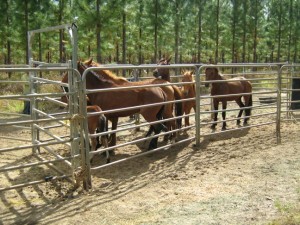Passive Trapping aims to capture horses with minimal interference from humans. Horses are allowed to enter the traps themselves to access food, water or salt licks. Traps can be very large or small but all have a gate that can be triggered to shut when horses enter or access the food, water or lick. Sometime “coacher” mares, who are trained to use the traps are used to guide groups into the trap. Some trapping systems also use CCT cameras to monitor the trapping process.
Like any method, adherence to best practice guidelines is imperative for this technique to be deemed humane. For example, horses must not be kept in the trap without food and water for long periods. Trained handlers must be used and horse transport to other facilities must also follow humane guidelines. Properly implemented, however, passive trapping provides a “least stress” option for removing horses from the land.
Experience among our member groups, who have re-homed brumbies caught by various methods, indicates that passively trapped horses are quieter, easier to approach and train and transition better to new homes than horses that have been chased during capture.






